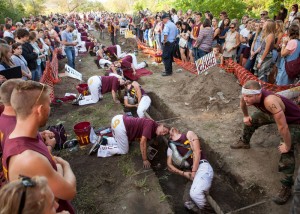Context:
G is a Korean American freshman studying Computer Science at USC. She has heard this story from her mother, who was born and raised in Korea but moved to Hawaii. That’s where G lived before she came to USC. According to G, her mom has told her this story countless times, and it is a very popular and well-known story.
Text:
There were two brothers, Heungbu and Nolbu, and they were both from a rich family. Nolbu is the older brother, he’s very greedy. The younger brother is Heungbu and he’s very kind. When their father died and it was time to split the fortune he left behind, the older brother takes everything. But, Heungbu is nice, so he doesn’t fight back or anything. He just accepts it.
There was a baby bird, a swallow. There was a snake trying to eat the swallow. Heungbu chased the snake away, saving the swallow. The baby bird had a broken leg, and Heungbu treated it for him. Three days later, the swallow got better, left, and came back with pumpkin seeds. So, Heungbu plants it in his backyard and when it was time to harvest, the pumpkin was full of treasure and gold.
The rumor spread that Heungbu became wealthy. His brother, the greedy one, asks him how he got so wealthy. Heungbu tells his brother. When Nolbu sees a swallow, he purposefully breaks the swallow’s leg and then heals it. The swallow comes back with pumpkin see, and when it was time to harvest, goblins came out of the pumpkin beating up his children and taking his fortune away.
Analysis:
This tale outlines two very stark characters in close contrast to showcase a logical sequence of events that follow their lives. Tales travel along the supernatural and realistically impossible, operating on events and logic that do not apply in the real world. There is no pumpkin seed in the world that can summon treasure and gold, or goblins (goblins do not exist or been questioned to exist like a yeti would be in a legend). There is no animal (real world entity) that is magical enough to differentiate magical pumpkin seeds, like that swallow. The objects of the folktale on which the plot occurs and the characters are propelled are illogical and extraordinary, an irrefutable kind of “not real” that occurs in a world that is not our own. However, though the events and plot devices themselves are not real or rational, what is logical is the actions of the characters caused by the devices. According to Oring, a “tale’s climax is the logical result of an episodic sequence.” Heungbu’s kindness and benevolence is met with Nolbu’s greed and malevolence, earning both of them respective consequences based on the caliber of morality their distinctive personalities the real world’s principles hold them in. These characters are unchanging and idle to exaggerate those social noems. It is accepted that kindness earns respect and good fortune, and as Korean culture is mostly dictated by Confucian values, Heungbu’s loyalty to his family in spite of his brother’s mistakes makes him a template of good character for Korean culture. Nolbu is the opposite; insensitive to family, uncooperative, and endlessly greedy, hence a moral villain for his Korean audience. This tale engineers Korean culture values into a supernatural order of events that follow a logical reasoning, so that the resolution is not only predictable for the audience but inevitable and therefore applicable in metaphor in real life.

